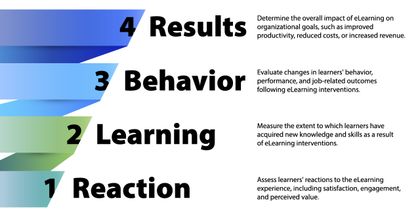Unveiling the Metrics: How to Measure the Effectiveness of eLearning Initiatives
🍿 5 min. read
In the rapidly evolving landscape of education and training, eLearning remains a transformative force, offering organizations unparalleled opportunities to deliver flexible, scalable, and cost-effective learning experiences. However, to truly harness the power of eLearning and maximize its impact, it's essential to have mechanisms in place for measuring its effectiveness. In this comprehensive guide, we'll explore the key metrics, methodologies, and best practices for evaluating the effectiveness of eLearning initiatives and driving continuous improvement.
🔍 What you’ll find in this post
Understanding the Importance of Measuring eLearning Effectiveness
You don’t know what you don’t know. You may have the best eLearning program around, but if you aren’t measuring its effectiveness, you have no way of knowing if it’s actually doing the job you wanted it to do. Methodical measurement of eLearning effectiveness serves multiple purposes. From informing decision-making and demonstrating ROI for your C-suite, to driving continuous improvement and enhancing engagement for your learners, everyone wins when you can quantify how effective your eLearning is.
Inform Decision-Making
Data-driven insights enable organizations to make informed decisions about the design, delivery, and optimization of eLearning initiatives.
Demonstrate ROI
By quantifying the impact of eLearning on learner outcomes, organizations can demonstrate the return on investment (ROI) of their training programs.
Drive Continuous Improvement
Ongoing evaluation allows organizations to identify strengths, weaknesses, and areas for improvement in eLearning content and delivery methods.
Enhance Learner Engagement
By understanding what works and what doesn't, organizations can tailor eLearning experiences to better engage learners and meet their diverse needs.
Key Metrics for Measuring eLearning Effectiveness
How do you go about measuring effectiveness? Fortunately, there are many metrics available to help evaluate the effectiveness of eLearning initiatives, allowing organizations to track metrics across different dimensions.
👉Learn more: Explore employee learning analytics.
Learner Engagement Metrics
Most LMS systems offer built-in learner engagement metrics. Course completion rate will indicate the percentage of learners who successfully complete an eLearning course or module. Average time spent by learners on each course or module indicates their level of engagement and interest. And interactivity metrics will give insight to the extent to which learners interact with course content, such as completing quizzes, participating in discussions, or accessing supplementary resources.
Learning Outcomes Metrics
In addition to engagement, you can also measure outcomes. Track your learners’ knowledge acquisition to assess understanding and retention of course material. Pre- and post-assessments, quizzes, and knowledge checks will give you insight here. Measure skill mastery, or learners’ proficiency in applying acquired knowledge and skills in real-world scenarios or job-related tasks. And measure performance improvement by tracking changes in learners' performance metrics, productivity levels, and job effectiveness following eLearning interventions.
Satisfaction and Feedback Metrics
Learner satisfaction can be measured through surveys, feedback forms, and course evaluations, all of which provide insights into learners' overall satisfaction with the eLearning experience, including content relevance, usability, and instructor effectiveness. Likewise, instructor feedback can evaluate the effectiveness of instructors or facilitators in delivering eLearning content, providing support, and facilitating learner engagement.
Business Impact Metrics
Keep your C-suite happy by measuring ROI and cost savings. This quantifies the financial impact of eLearning initiatives in terms of cost savings, productivity gains, and revenue generation. Likewise, compliance and performance metrics can help track compliance with regulatory requirements, industry standards, and organizational performance goals following eLearning interventions.
Methodologies for Evaluating eLearning Effectiveness
There are many evaluation methodologies you can lean on to effectively measure eLearning effectiveness. We’ve highlighted some of our favorites here.
Kirkpatrick's Four Levels of Evaluation
Crafted in the 1950s, Dr. Donald Kirkpatrick’s model is the defacto standard for measuring effectiveness in training. It has endured, and evolved, for a reason.

Phillips' ROI Methodology
Jack Philips took the Kirkpatrick model and added in his ROI methodology. Sometimes referred to as Level 5, it looks to identify the costs and benefits. Calculate the total costs associated with eLearning development and implementation, as well as the tangible benefits in terms of improved performance and business outcomes. It also calculates the ROI ratio by dividing the net benefits (benefits minus costs) by the total costs and expressing it as a percentage.
👉Dig Deeper: Delve into how to measure the ROI of custom eLearning.
Net Promoter Score (NPS)
Commonly used in market research to gauge brand loyalty, net promoter scores can also be used to measure learner loyalty. Assess learners' likelihood to recommend the eLearning experience to others on a scale of 0 to 10. You can also categorize respondents into promoters (score 9-10), passives (score 7-8), and detractors (score 0-6) to gauge overall satisfaction and loyalty.
Continuous Improvement and Iterative Evaluation
Implement mechanisms for collecting ongoing feedback from learners, instructors, and stakeholders to identify areas for improvement and inform iterative updates to eLearning content and delivery methods. Then, analyze evaluation data, identify trends and patterns, and use insights to refine eLearning initiatives, address pain points, and optimize the overall learning experience. This ongoing process should lead to better and better results (and training!) over time.
Best Practices for Measuring eLearning Effectiveness
In addition to selecting appropriate metrics and evaluation methodologies, organizations can adopt best practices to enhance the effectiveness of their measurement efforts.
Align Evaluation with Business Goals
Ensure that evaluation metrics and methodologies are aligned with organizational objectives and priorities to demonstrate the value of eLearning in driving business success.
Collect Diverse Data
Don’t just rely on a single source of information. Gather quantitative and qualitative data from multiple sources, including learner assessments, surveys, performance metrics, and business impact analyses, to gain a comprehensive understanding of eLearning effectiveness.
Engage Stakeholders
No man, or training department, is an island. Involve key stakeholders, including learners, instructors, managers, and organizational leaders, in the evaluation process to gather diverse perspectives, foster buy-in, and promote accountability for results.
Iterate and Improve
Just because it’s published doesn’t mean it’s done. Use evaluation findings to identify strengths, weaknesses, and opportunities for improvement in eLearning content, delivery methods, and learner support mechanisms, and iterate continuously to enhance effectiveness. The beauty of eLearning is that it is a product that can easily evolve to meet changing needs and provide updated information.
Promote Transparency and Communication
Share evaluation results and insights with stakeholders transparently and communicate the value of eLearning initiatives in achieving organizational goals and driving continuous improvement.
Get started with EdgePoint
Measuring the effectiveness of eLearning initiatives is essential. By selecting appropriate metrics, employing evaluation methodologies, and adopting best practices, organizations can gain valuable insights into learner engagement, learning outcomes, and business impact, and optimize eLearning initiatives to meet organizational goals and learner needs. As eLearning continues to evolve and play an increasingly central role in education and training, effective measurement and evaluation will be key drivers of success in achieving desired outcomes and delivering tangible value to stakeholders.
Want to learn more? At EdgePoint Learning, we love talking shop, and can help get you on the right path. Get in touch today!

